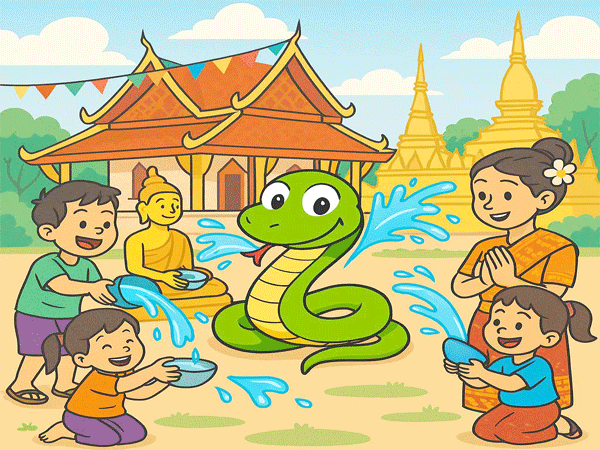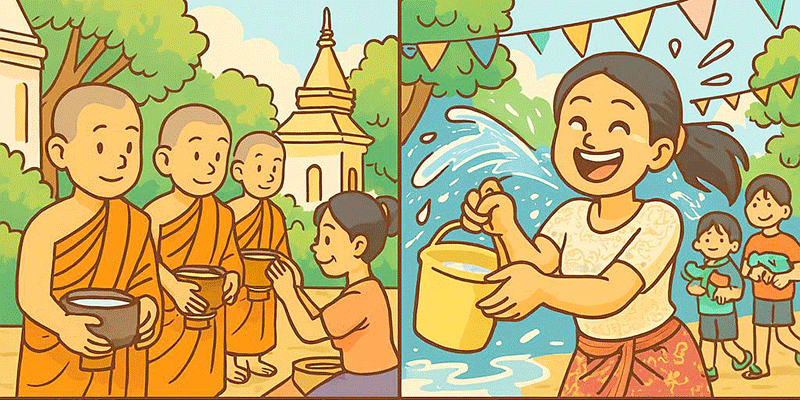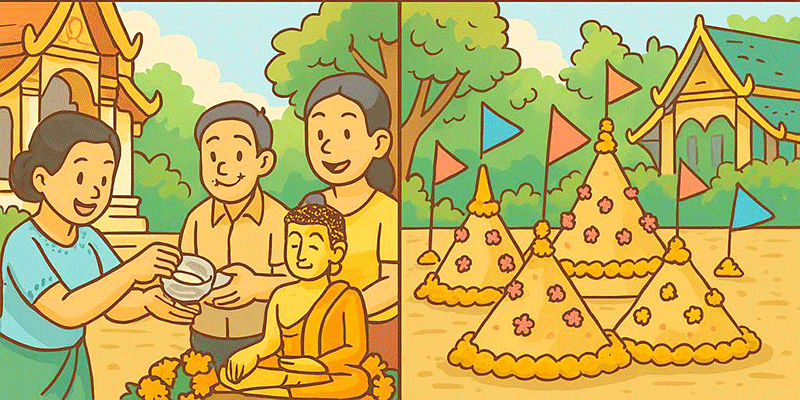Celebrating Lao new year 2568: a joyful start to the Year of the Snake
As the calendar turns to mid-April, the entire nation of Laos erupts into colour, laughter, and the splashing of water as the Lao New Year (Pi Mai Lao) celebrations get underway.
 |
| AI-generated image depicting Pi Mai Lao celebrations, with the new year being the Year of the Snake. |
From the bustling capital of Vientiane to the serene temples of Luang Prabang and the festive streets of Pakxe, the celebrations stretch across three unforgettable days, from April 14-16.
This year, the new year is symbolised by the snake, the Zodiac sign representing wisdom, adaptability, and renewal.
In the early morning, towns and villages across Laos are filled with the scent of fresh flowers as people gather at temples to perform Song Phra, a traditional ritual where scented water is gently poured over Buddha statues, washing away the misfortunes of the past year and ushering in good luck.
In Vientiane, Simeuang and Ongteu temples are filled with people tying white cotton threads around each other’s wrists in the Baci ceremony, bestowing blessings for good health, safety, and happiness in the year ahead.
In the afternoon, the country transforms into a giant splash zone as people take to the streets with buckets, water pistols, and hoses to drench everyone in sight. Water battles break out in streets, village corners, and even from balconies, as people of all ages joyfully soak one another. It’s not just about cooling off in the heat—it’s a symbolic cleansing, a way of washing away bad luck and starting anew.
In Luang Prabang, which is home to a UNESCO World Heritage Site, Pi Mai is both sacred and spectacular. Monks in saffron robes chant under the golden roofs of temples, while locals and tourists alike build sand stupas on riverbanks and in temple courtyards—miniature temples decorated with flowers, flags and incense sticks.
The city hosts the Nang Sang Khan procession while the legendary characters Phou Gyer and Nga Gyer put in an appearance, together with cultural shows and dances. The Prabang Buddha procession is another traditional and highly revered event.
Food stalls line the streets, offering seasonal favourites—sticky rice, grilled meats, papaya salad, and sweet coconut treats. The scent of grilled river fish wafts through the air as families gather to feast and raise toasts to the new year.
 |
 |
| AI-generated images highlight some of the main Pi Mai Lao traditions. |
The official celebrations take place over three days.
Day One: The Last Day of the Old Year (Sangkhan Louang)
This day serves as a farewell to the old year. Communities come together to clean their homes and public spaces, symbolising the removal of past misfortunes and the preparation for a fresh start. Buddha images are ceremonially washed with scented water, a ritual believed to purify and bring blessings in the coming year. This act of cleansing extends to the playful water fights that occur among friends and family, representing the washing away of sins and bad luck.
Day Two: Sangkhan Nao
The second day, Sangkhan Nao, is considered a transitional period, existing between the old and new years. It’s a time for reflection and merit-making. Many people visit temples to build sand stupas. It’s also customary to release animals such as fish, crabs, and birds, signifying the freeing of oneself from past wrongdoings and fostering compassion.
Day Three: The First Day of the New Year (Sangkhan Kheun Pi Mai)
The third day marks the official beginning of the new year. Festivities reach their peak with cultural performances, traditional music, and dance. In towns like Luang Prabang, processions featuring revered Buddha images take place, allowing devotees to pay their respects and seek blessings. Families gather for Baci ceremonies, where white cotton threads are tied around the wrists to call back wandering spirits and ensure good fortune. The joyous water splashing continues, reinforcing themes of renewal and communal harmony.
The Year of the Snake is associated with transformation, deep thinking, and careful planning. In Lao belief, the snake is not just a reptile, but a wise and spiritual creature, closely linked to the mythical Naga, guardian of rivers and protector of life.
As Laos navigates the challenges of modern development, environmental change, and social growth, many believe the snake brings timely energy for thoughtful progress and renewal.
Pi Mai is more than just a New Year festival—it’s a celebration of Lao identity, unity, and spirit. It brings families together, invites visitors to experience the heart of Lao culture, and offers everyone a moment to pause, reconnect, and refresh.
Whether you’re tossing water in the streets of Vientiane, watching cultural performances in Luang Prabang, or taking part in temple rituals in rural villages, Pi Mai Lao offers an unforgettable journey into the soul of Laos.
As the country steps into the Year of the Snake, the message is clear: this is a time to embrace change with wisdom, celebrate with joy, and carry the spirit of community forward into a brighter future.
By Times Reporters
(Latest Update April 11, 2025)
|




